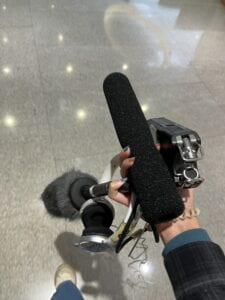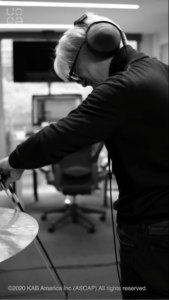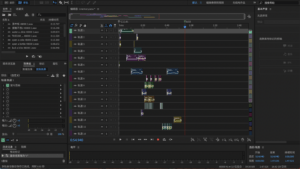Concept
The memory that I chose happened on a rainy night. I recalled I was having a sleepover at my friend’s house, and she told us a ghost story. Someone turned the light off. In the dim room, with everyone holding their breath, the tic tac of the clock was the only thing to be heard.
When she talked about how the ghost was moving around with heavy steps in an abandoned hospital, trying to block the invaders, my palms sweated and I could feel my heart pounding. The steps, heartbeats, and the distant thunderstorm seemed combined together and created a feeling where illusion and reality were integrated.
For a split second, I had no clue where I was. Was I at my friend’s home? Was I being chased in that gloomy asylum? Or maybe I was standing in the rain, frozen. Before I knew it, I was pulled back into reality by the sound of my friend pouring juice.
Inspired by that piece of memory, I decided to create a soundscape using high-frequency sound clips to depict a sense of instability and confusion. By adding echo and reverb to some of the clips, I hope to blur the boundary of what was real and what was in my mind.
Process

In an attempt to create the feeling that I mentioned above, I recorded the sounds of locking a bicycle, opening a can, pouring liquor, knocking the wood and glass, some notes on the piano, and so on. These sounds had a mysterious vibe sonically and were mostly high frequency, which could better convey my mood in the memory. And since they can be easily distinguished from the background sound, it was easy for me to reduce the noise and manipulate them.
Though I didn’t adopt specific techniques when recording the sound, I did try to get the microphone close enough to the objects that made sounds and tried to fix it in one spot, so that there would be less noise made by moving my equipment.
When editing the sounds, since I was not very familiar with adobe audition, I was quite confused by the multiple effects. And it was hard to tell what changes they could make to the clips just by looking at their names. What I did was explore and experiment at my best. For each clip, I tried out as many effects as possible and tried to tell the nuances. By the end of my project, I got a better understanding of what each effect stands for.

And when I was told that the sound of instruments should be limited to one to two notes, I had to remove some piano clips that I added to my soundscape. After this, I struggled for quite some while in order to manipulate other sounds while still conveying the same feeling. But the process actually got me to realize the meaning of the project in a deeper way. Abandoning the traditional way of making music, we were exploring a new way of expression by collecting the sounds of daily routine and nature. It also reminded me of a live-stream performance in 2020 by Japanese musician Ryuichi Sakamoto, in which he adopted a similar way of expressing sounds, comforting millions of people when the pandemic first broke out.
Conclusion
If given more time, I would make some of the clips sound more spacious and adjust the interval of each clip more carefully so that the audience would enjoy a better rhythm.
Presentation Feedback
A few classmates said that they like the buzzing sound at the beginning which seemed to lead the way to the following part. And Inmi said that she enjoyed the constant background sound, which I appreciate very much.
While the volume of my soundtrack in the classroom was relatively low compared to others and that eliminated quite a few detailed sounds that I added to the track. When talking about it with Inmi after class, I realized that I didn’t do very well in the mastering process. If given another chance, I would take the mastering stage seriously and add some final touches.
Image of Audition

